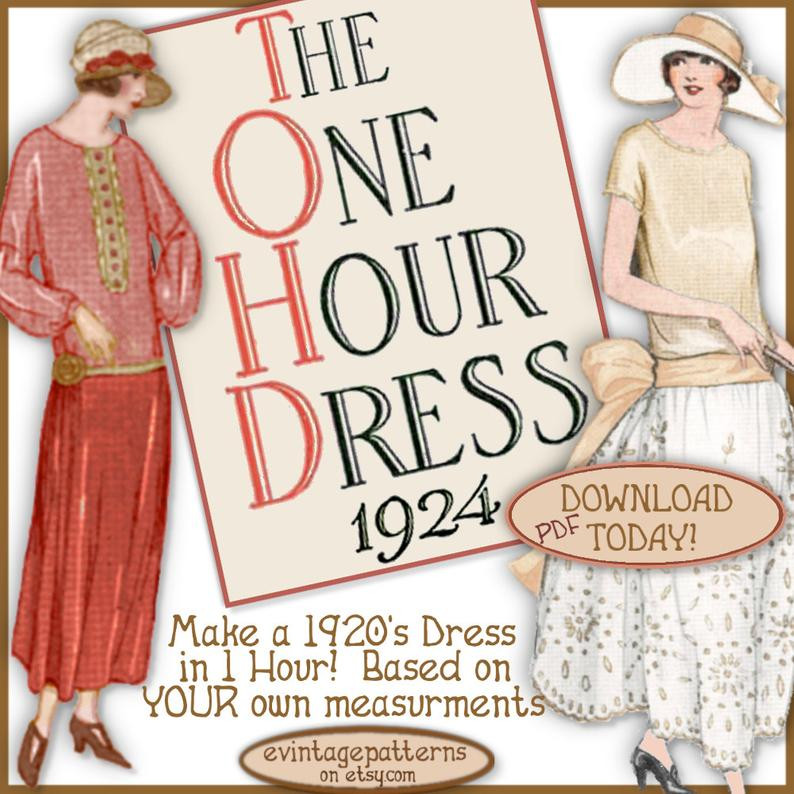Good morning, I’m Morgan Donner and today I’d like to show you how I make this 1920s “one-hour dress”.
Now you may have noticed those quote marks because the pattern is called the “one-hour dress”, it does not necessarily mean that you are going to take only one hour to make it! Or at least I certainly didn’t, it took me maybe three hours? Which is still pretty fast! So let me go ahead and show you it.
The 1920’s are not necessarily my area of expertise (not that I have any expertise in any area) but it’s definitely not a time that I know a whole lot about, so I started off this project the way I did pretty much every other project — which is to look at a Pinterest board! I found lots of really cute dresses. I wanted something that felt very normal day to day type clothing when it comes to 1920s and there are lots of really cool street photography images showing women just about the town!

The ones with coats are kind of frustrating because I knew I wasn’t going to make a coat, but there are several with cute, cute little dresses! One thing that I noticed right away is it seems very, very common to be wearing a hat, so I ordered that from the internet (so I didn’t have to make it) but for the dress I stumbled across this French magazine of some sort, that showed several ‘how to make your own dresses’ patterns. It gave ideas and hints — it wasn’t a full on “cut it out and put it on the paper” patterns, no it was more like take your waist, bust, hip, height measurements and toss that onto the fabric and cut out a dress!
There’s some kind of news article about a woman who reportedly made a dress in like 48 minutes or something, which is super cool! I was like ‘know what, I only have one afternoon, that seems like that fits the bill!” and the dress pattern in truth is very simple. It’s really whatever length you want your sleeves to be. The sleeves are cut on one, they’re not cut with a separate seam, it’s literally just a T! Then the whole waist, which if you’re familiar with 1920s, usually you don’t have much fitting in the waist, it’s more of a straight down until you hit the hips and then you have some flair going on in the skirt, not a lot, but there’s definitely a lot of swishing movement.

There’s tons of images of women with lots of pleats and gathers in the skirt, sometimes they had lots of fun and did different fabrics in the gores and it’s very cute! Digging through my closet, I found this polka dot fabric and I knew I had seen a couple images of ladies wearing dresses with a polka dot type fabric and I was like “all right, I think that’ll work!” You may have heard me in the past advocate for doing a mock-up, and even for something as simple as this, I still recommend it, so I went ahead and did a quick mock-up to verify that the instructions, which said to use the bust as your main measurement for the whole torso column, whether that would work out and it did! It was perfectly fine, there’s some gathering and pleating in the hips, and I wanted to verify that I had the right height sorted out. I wanted to verify the length of the gown – my mock-up was way too short, but I also knew that (I only had so much fabric) and I figured it would at least give me a ballpark to show how much longer it needed to be to be a more appropriately 1920s length.
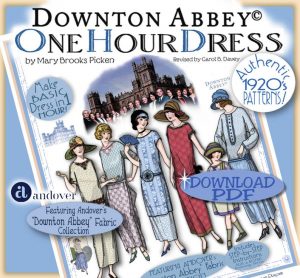
One of the great things about using a mock-up for this pattern is that I could then just take the mock up and put it down on top of the fabric laid out! I didn’t have to remesh and draw the various measurement components which is fantastic I love it when I can cut corners like that so good the one hour dress at its most simple uses a sort of capital.
I shape, I chose quite short sleeves but you could certainly make your sleeves longer or you can make your hips wider if you wanted more fullness in the skirt but at its core it’s quite a simple garment after flipping the dress inside out also the side seam first stopping at the hips I have lots of thread colors but no dark blue the moment apparently.
I guess I’ll have to use black instead but that’s okay it shouldn’t show too much now here’s where the side seam meets hip and I could just fold it like this to make a sort of large pleat which would definitely be the fastest method, but I really like these extant examples I’ve seen with the gathered hips so I’ll cut perpendicularly to the side seam going about two inches in and then this excess skirt here on the bottom needs to be gathered up into the short – opening at the top.
I could gather it by machine but with just a foot or stitching. I’ll just do it by hand it’ll honestly be just as fast once the lower section is about the same size across as the Ungava top. I can just pin them together and then run them through the sewing machine and here’s what that looks like on the outside of the dress the neckline and the sleeve edges are still unfinished so let’s go ahead and get those taken care of for binding the sleeves and for the eventual belt sort of sash.
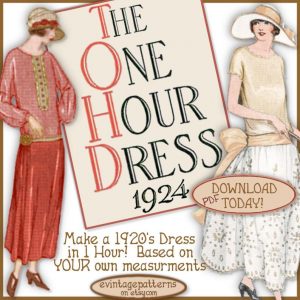
I have some white silk that I need to cut down into smaller strips. I’ve cut a two inch wide strip for these sleeves no fancy bias here just straight grain I’ll fold it in half and then stitch it down to the sleeve edge after sewing that first line of stitching for the binding. I’ll iron it downward we’re looking at the outside of the sleeve here and then flip it over and on the inside fold it over again at towards the inside and iron it down again the idea here is that.
I will be catching the back side of the binding there we go see the little stitches in a row normally. I’d prefer to do this by hand, but I don’t have a lot of time today. So we’re just rushing it along now for the neckline you can see here that I’ve rolled the edge down twice and incorporated the binding in that it’s a little bit bulky and I probably should have done the neckline first and then did the sleeve binding.
But it’s okay, it’s all fine in the end, so I will continue doing my two fold sewing normally. I would pin the whole thing in place before doing any stitching but it’s a lot faster especially for a straight seam like this, to go ahead and just pin the first bit to keep things in place, while you’re getting set up. But after that you can use the fact that this fabric is a non-stretch and you can sort of use a little bit of tension to hold that double fold in place while you’re sewing: oh goodness it’s a 5 o’clock and my friends are coming at 6:00 to pick me up for this party.
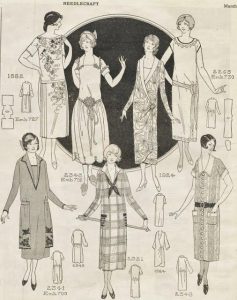
So I need to get moving here the binding was just a little bit too thick to go through the machine. I’m tacking it down by hand and then while I still have the thread and needle already in place. I’ll go ahead and stitch the other end of the sleeve together so that the sleeve is just bound together at the very edge and tada.
I do kind of wish that I had made the opening in the binding here on the underside of the arm. That it was just one continuous length not broken up by this bit of stitching. But it’s ok, not the end of the world do remember to clip all of your corners inside the dress. There’s going to be at least one under each arm and that’ll help. It move correctly once it’s on the body with the neckline done.
I’m going to try the dress on very quickly and here where my bra straps are, I’ve placed a couple of pins on the back panel of fabric and that’s going to tell me where to start my neckline. So here’s that bra strap pin and it’s on the back half, I’m actually instead of going to evenly pinned it together.
I’m going to sort of gorge one side down what that’s going to do is make it. That the neckline in the front is going to be a little bit more roomy a little bit further down the neck lining the back, which if you’ve done any sewing or if you just go look at any of your t-shirts right now, you’ll note that the neckline is always more in the front than it is, in the back it’s or I should say: it’s a little bit lower in the front than it is in the back otherwise.
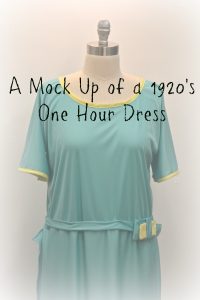
So I’m gonna give this a quick ironing to make everything flatten nice with the sash done we’ll go ahead and tie it on just above or right at really that gathered section of the skirt that we put in earlier after a bit of ruching and arranging I’ve got a cute little bow so I hope you guys really enjoyed watching me make the dress if you have any questions do feel free to leave them below in the comments if you attempted to make your own 1920s one hour dress I would love to see that I’m a big fan do please tag me on instagram at Morgan Donner I love seeing all your guys things it was lots and lots of fun to research something that was so completely out of my normal historical clothing research comfort zone it was really neat to see something so different and new who knows what I’ll decide to look up next I do still need to do those Janet Arnold stays well I think that just about wraps it up so I hope you guys all have a wonderful wonderful day and I’ll see you later good night that just about wraps everything up so I hope you guys all have a lot of fun whoa and got real weird the accents there
